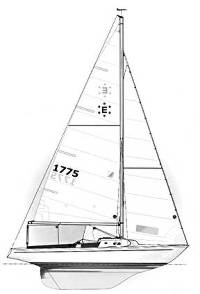Ensign
One Designr
In 1962 Carl Alberg designed the Ensign as a family daysailer and one-design racer. The Ensign design was a development of a previous Alberg design called the Electra, which had larger accommodations but a smaller cockpit.
If you are not familiar with Carl Alberg I can tell you that he distinguished himself as the designer of capable and fast boats back in the days when the line between racer and cruiser was not so distinctly drawn. The conventional-looking Alberg 35 is today sought after as a tough cruising boat. In 1963, however, many races were won in Alberg 35s. Alberg was not a very adventurous designer. His boats all tend to look the same, i.e., flat sheers, cutaway full keels, long overhangs and slablike topsides with firm bilges.
With 1,776 Ensigns built by Pearson between 1962 and 1983, interest in the boat waned and production was stopped. But as the market filled up with daysailers that required life jackets and crash helmets, the search for a safe and sane daysailer resulted in renewed interest in the Ensign. Today there are 45 active fleets in the United States.
In 1995 Zeke Durica of Dunedin, Florida, set up a shop, Ensign Spars Inc., to supply replacement parts to the aging fleet of Ensigns. This led to the purchase of the original molds and, this past year, the taking of orders for new Ensigns. The new Classic Ensigns began at hull number 2,000 and are available on a semicustom basis. Two are currently in the water with numbers three and four on the way.
If you wonder what has made the Ensign such a durable design I would have to say it boils down to that big, deep cockpit, the generous displacement and the stiffness of the boat in terms of stability. This stiffness comes from a hull shape with a wide BWL, a firm turn to the bilge and 1,200 pounds of internal lead ballast. That's a ballast-to-displacement ratio of 40 percent. Interestingly, the original construction drawing from 1962 calls for 2,000 pounds of ballast.
The long overhangs are an artifact of the old CCA rule where a boat's sailing length was approximated by a waterline taken 7-percent of beam above the DWL. This rule produced short DWLs with the justification that once a boat heels over its sailing length is increased. Well, in some cases maybe. Nonetheless this was once the look du jour and pretty much reigned until the IMS reintroduced short ends and longer DWLs. The D/L of the Ensign is 213.
Take a look at that keel. It sure is long, but if you go back a few decades and look at 12-meters like Vim and Columbia you will see a family resemblance, although the Ensign keel is proportionally much longer.
The original drawings show a head nestled between the V-berths. If you do go cruising in your Ensign you will have to cook in the cockpit. You might also want to consider the optional doors for the cuddy cabin. (my computer's spell check always wants that to be "cruddy cabin"). There is enough room below to put a small table between the berths. But I'm not sure there is sufficient sitting headroom to make the table useful. I suspect not. Oh well, a toasted cheese sandwich and a bowl of tomato soup can be cradled in your lap easily. If the rain you can hope for an invite over to the Swan 65 anchored nearby.
I used to fantasize about sending my two boys off to go cruising on a boat like this. Now they just tell me, "We're taking the boat out, Dad," and there goes my boat. I couldn't be more proud. I think proper seamanship is best learned when you reduce the mechanical-electrical variables.
I wish Zeke the best of luck with his new Classic Ensign.

Comments